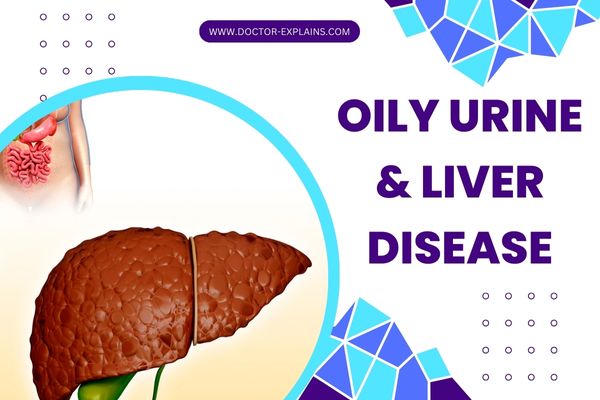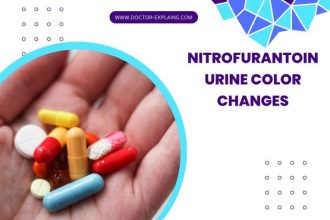Oily Urine: Key facts
- Oily urine is a term used to describe urine when it has an oil film or rainbow pattern on the surface of the toilet or urine container.
- Oily-looking urine may also appear as darker yellow oily drops on the surface of urine or slightly turbid urine.
- Causes of oily urine include chyluria, a ketogenic diet, diabetes, dehydration, nephrotic syndrome, and other possible causes.
- Symptoms of oily urine vary depending on the underlying cause, such as milky white urine, dysuria, blood in the urine, blood clots in urine, etc.
- Consult a doctor if you have persistent oily-looking urine or rainbow pattern on the surface of urine, sweet urine smell (ketonuria), dysuria, scanty urine, foamy urine, turbid or bloody urine, swelling of your legs, eyelids, or your abdomen, fever or chills, obstruction of urine, or severe urinary bladder or loin pain.
What is oily urine? What does it look like?
Oily urine is a term used to describe urine when it has an oil film or rainbow pattern (urine looks like an oil slick). It is on the surface of urine in the toilet or container.
Oily-looking urine may also appear as darker yellow oily drops on the surface of urine. People also may describe slight turbidity in urine as oily or fatty urine.
Oily urine is not necessarily due to oils or fats in urine. The oily look of the urine is can be due to several factors, such as dehydration, some supplements, and contamination with genital secretions.
Causes of Oily urine.
[1] Chyluria
Chyluria is the presence of lymphatic fluid in urine. The lymphatic fluid is a protein and fat-rich fluid that comes from excess fluids in cells and tissues.
In some cases, the lymphatic fluid leaks into urine through the kidney leading to milky white urine with oily consistency or showing oil specks on its surface.
Common causes of chyluria (reference):
- Parasitic infections (such as Wuchereria bancrofti causing filariasis).
- Trauma
- Surgery (kidney surgery, aortoiliac bypass).
- Infections.
- Some tumors.
- Lymphatic malformations.
- Radiation.
- Pregnancy.
Symptoms of Chyluria (reference):
- Milky white urine.
- The oily or fatty look of the urine or the presence of rainbow specks on the surface of urine).
- Dysuria (pain during urination).
- Blood in the urine.
- Blood clots in urine (may cause urine retention).
- Systemic symptoms such as weight loss, swelling of limbs, child, fever, etc.
[2] Ketogenic diet.
People on a low-carb, ketogenic diet restrict carbohydrates and rely mainly on fats. As a result, your body burns fats instead of sugar to get energy.
Fat metabolism (when in excess) leads to the production of ketone bodies in the blood. Excess ketones may appear in the urine of people on a ketogenic diet and cause an oily appearance (floating oil or rainbow pattern on the surface of urine).
The condition is explained in the below video from (The Doctors) shown by Dr. Aaron Spitz:
Discuss the issue with your doctor or dietitian, especially if you have other symptoms such as:
- Polyuria (urinating too much urine).
- Bad breath odor.
- Acetone or sweet-smelling urine.
- Thirst sensation.
- Headaches.
- Muscle cramps or spasms.
- Unusually fatigue or weakness.
My Opinion:
Due to the presence of ketone bodies, oily-looking urine is not packed by strong evidence from research or credible medical books.
During my research, I didn’t find a study or a book mentioning “oily urine” as a sign in patients with ketone bodies in urine.
The only evidence is “expert opinions,” such as Dr. Aron Spits (in the video) above.
Also, I health with hundreds of patients with ketosis and ketoacidosis, and not a single one of them reported symptoms such as “oily urine”.
Ketone bodies are end-products of fat breakdown. Unlike fats, they are water-soluble and don’t have the characteristics of fat or oil.
So, I am personally not sure if ketonuria leads to oily-looking urine or oil slicks on the surface of urine.
[3] Diabetic ketosis or Ketoacidosis
The most common cause of excessive ketones in the urine is diabetes. Patients with diabetes (particularly type one diabetes that typically affects young people) may have severe insulin deficiency.
When insulin becomes deficient, your body turns into an alternative fuel (fats). And by a mechanism similar to that of a ketogenic diet, ketones bodies (the end products of fat metabolism) appear in urine and may cause the oily appearance of urine.
However, the oily look is less common due to large volumes of urine (due to high glucose in urine drawing more water leading to polyuria and clear, water-like urine.
This can happen with the following:
- Patients with undiagnosed diabetes.
- Patients with poorly controlled diabetes.
- Patiens with DKA (diabetic ketoacidosis).
Symptoms of undiagnosed diabetes:
- Polyuria (urinating too much urine): High blood sugar levels cause the kidneys to work harder to filter and absorb the excess sugar. If the kidneys can’t keep up, the excess sugar and fluids drawn from your tissues are excreted into your urine. This leads to frequent urination and dehydration.
- Bad breath odor: When your body burns fat for energy, it produces ketones, which can cause a fruity or acetone-like smell on your breath.
- Acetone or sweet-smelling urine: High levels of ketones in the urine can cause a sweet or fruity smell.
- Thirst sensation: High blood sugar levels pull fluid from tissues, leading to dehydration and thirst.
- Headaches: Dehydration caused by frequent urination can lead to headaches.
- Muscle cramps or spasms: Electrolyte imbalances caused by frequent urination can lead to muscle cramps or spasms.
- Unusual fatigue or weakness: High blood sugar levels can cause fatigue or weakness.
Symptoms of DKA:
- Fruity-smelling breath: The presence of ketones in the body can cause a fruity or acetone-like smell on the breath.
- Nausea and vomiting: Elevated levels of ketones can cause nausea and vomiting.
- Stomach pain: Some people with DKA experience abdominal pain, which can be severe. It may also be associated with nausea and vomiting.
- Rapid breathing: With DKA, breathing tends to become rapid and shallow.
- Confusion: DKA can cause confusion, drowsiness, and decreased consciousness.
- Unusual fatigue or weakness: High blood sugar levels can cause fatigue or weakness.
- Dry mouth and skin: Dehydration caused by frequent urination can lead to dry mouth and skin.
- Abnormal Urine: peeing too much urine that looks clear and water-like urine. A rainbow pattern or oil slick pattern may appear on the urine surface.
Consult your doctor immediately if you think you have symptoms consistent with diabetes or diabetic ketoacidosis.
Refer to the first section for my personal opinion on whether ketone bodies in urine causes.
[4] Dehydration
Dehydration can also cause urine to appear oily or fatty. When you are dehydrated, your urine becomes more concentrated, and the solutes in urine become denser and can cause an oily appearance.
Dehydration typically causes deep yellow (looking like oil) and low or below-average urine volume.
In such a case, urine doesn’t actually contain fat or oily-like components. It only attains the appearance of oil due to high concentrations of waste products in urine.
[5] Nephrotic syndrome
nephrotic syndrome is a kidney disease that leads to passing too much protein in the urine (and fats). Nephrotic syndrome is caused by the following:
- Some diseases, such as diabetes.
- Systemic lupus erythematosus (lupus nep
- Certain medications, such as some antibiotics and analgesics.
- Some infections, such as Hepatitis C, HIV, etc.
A patient with nephrotic syndrome typically complains from:
- Polyuria.
- Clear-looking (light yellow or water-like urine).
- Bubbles in urine.
- Swelling on the eyelids (particularly in the morning).
- Swelling on lower limbs.
- Weight gain due to water retention.
- Loss of appetite.
Fats are often present in urine and may cause the oily appearance of urine in patients with nephrotic syndrome. Call your doctor immediately if you think you have nephrotic syndrome.
[6] Other possible causes
- Alcoholic ketosis: ketonuria due to excess alcoholic beverage intake
- Excess intake of water-soluble vitamins
- False oil in urine:
- UTI
- Toilet detergents
- Concentrated urine
- Bilirubinuria (bilirubin in urine): in patients with liver diseases or biliary obstruction (We’ve discussed the relationship between oily urine and liver diseases in this article).
- Prostatic secretions
- Contamination with vaginal secretion.
When to worry?
See a doctor if you have a persistent abnormal oily look or urine or rainbow pattern on the surface of urine or if the condition is associated with:
- Milky white urine.
- Sweet urine smell (ketonuria).
- Dysuria (painful urination).
- Scanty urine (oliguria) or too much urine (polyuria).
- Foamy urine.
- Turbid or bloody urine.
- Swelling of your legs, eyelids, or your abdomen.
- Fever or chills.
- Obstruction of urine (retention).
- Severe urinary bladder (lower abdominal pain) or loin pain.





